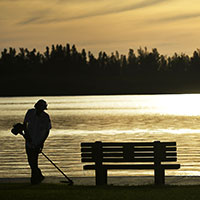 Environmental regulators cracking down on lagoon pollution
Environmental regulators cracking down on lagoon pollution
STORY BY SUE COCKING (Week of October 1, 2020)
Citing weak sea grass recovery from recent algae blooms in the central Indian River Lagoon between Sebastian Inlet and St. Lucie County, state environmental regulators are requiring Indian River County, the city of Vero Beach, and other local government bodies and farms to drastically reduce the amount of pollution flowing into the estuary.
The Florida Department of Environmental Regulation is, for the first time, requiring local entities in our area to meet concrete targets for reducing the amounts of nitrogen and phosphorus from wastewater, stormwater, agriculture and septic systems that enter the lagoon.
Nitrogen and phosphorus are the main chemicals that feed algae blooms that smother sea grass – the foundation of the lagoon’s health.
Representatives from the city and county and other agencies learned about the updated lagoon management plan at a webinar conducted by FDEP. They are required to tell the agency whether they can meet the revised limits in five to 10 years and what projects they could undertake to meet those targets.
According to FDEP calculations, more than 265,000 pounds of nitrogen and more than 38,000 pounds of phosphorus enter the lagoon each year between the Wabasso Causeway and the St. Lucie County line. The new allocations call for reducing those loads by more than half.
The state calculates about 49,000 pounds of nitrogen and about 7,000 pounds of phosphorus go into the estuary each year from manmade sources just in Vero Beach. Those loads also would have to be cut by more than half. Other entities with new pollutant limits include the towns of Indian River Shores and Orchid, the water control districts, the cities of Sebastian and Fellsmere and local agricultural producers.
FDEP officials told participants at the webinar that the new targets are necessary because sea grass cover in the central lagoon has not recovered sufficiently from the brown algae “superbloom” in 2011 and subsequent blooms. The St. Johns River Water Management District says sea grasses only cover about 42 percent of the lagoon bottom compared to 2007 levels.
Eric Charest, Indian River County’s natural resources manager, wrote in an email to Vero Beach 32963 that “creating enough projects to meet those reductions has been preliminarily calculated in the range of $400 (million) to $450 million. This will create a financial hardship if sufficient grant funds are not acquired.” He added that it’s premature to speculate on a time frame for achieving the state-mandated targets.
Existing county projects that reduce nitrogen and phosphorus pollution to the lagoon include a screening system that removes freshwater plants and trash from the Main Relief Canal near its outflow into the lagoon; the Egret Marsh and Osprey Acres stormwater parks; the Osprey Marsh nutrient removal facility; Spoonbill Marsh; and the North Relief Canal mechanical vegetation/debris removal facility. Another nutrient reduction project known as Moorhen Marsh is in the works.
In Vero Beach, public works director Matthew Mitts and water and sewer director Rob Bolton said they saw the new pollution allocations coming years ago, and neither foresaw financial hardships in meeting the targets.
Bolton said to reduce nutrient loading from wastewater, stormwater, agriculture and septic systems, the city will bump up septic-to-sewer conversions; expand modeling for ways to capture nitrogen from the soil before it enters the lagoon; plan to build a new wastewater treatment plant next to the airport with help from state grants; and use excess filtering capacity from the water treatment plant to further filter irrigation water before it gets to the lagoon.
“With all these projects, we will probably come very close to hitting that goal they’ve given us,” Bolton said.




